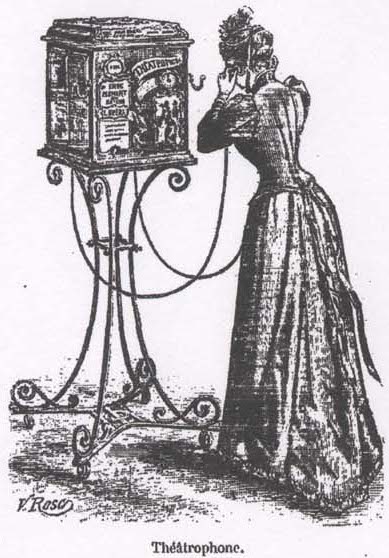Science fiction can be a great place to discuss the social and psychological impact of technological advances, but its ability to predict otherwise unforeseen developments is not actually that clear. Arguably most commonly cited science fiction prophesies are simply slight extrapolations of contemporary technology and widely discussed proposals, the result of a tendency, particularly among 21st century commentators, to underestimate the sophistication of previous generations.Case in point. Here's an excerpt from an article National Geographic ran on the predictions of Jules Verne:
In an 1889 article, "In the Year 2889," Jules Verne described an alternative to newspapers: "Instead of being printed, the Earth Chronicle is every morning spoken to subscribers, who, from interesting conversations with reporters, statesmen and scientists, learn the news of the day." The first newscast didn't happen until 1920, according to the Associated Press—nearly 30 years after Verne imagined it. The first network-television newscast would have to wait another 28 years, according to CBS News. By 1974 millions were able to watch U.S. President Richard Nixon resign on TV.
Putting aside the quibble that Verne's son probably wrote most of "In the Year 2889," this gets the facts wrong and completely misses the larger context. Here's the pertinent paragraph [emphasis added]:
Every one is familiar with Fritz Napoleon Smith's system—a system made possible by the enormous development of telephony during the last hundred years. Instead of being printed, the Earth Chronicle is every morning spoken to subscribers, who, in interesting conversations with reporters, statesmen, and scientists, learn the news of the day. Furthermore, each subscriber owns a phonograph, and to this instrument he leaves the task of gathering the news whenever he happens not to be in a mood to listen directly himself. As for purchasers of single copies, they can at a very trifling cost learn all that is in the paper of the day at any of the innumerable phonographs set up nearly everywhere.
Now some context. This wasn't a bold claim. Edward Bellamy had made a similar prediction the year before. More importantly, to readers in the late 1880s, neither man was saying anything particularly surprising here. Lots of people were discussing these ideas and engineers in the orbits of Bell and Edison were working on adapting the telephone for broadcasting with the first newscast happening not in 1920 but in 1890.
From Wikipedia:
The origin of the théâtrophone can be traced to a telephonic transmission system demonstrated by Clément Ader at the 1881 International Exposition of Electricity in Paris. The system was inaugurated by the French President Jules Grévy, and allowed broadcasting of concerts or plays. Ader had arranged 80 telephone transmitters across the front of a stage to create a form of binaural stereophonic sound. It was the first two-channel audio system, and consisted of a series of telephone transmitters connected from the stage of the Paris Opera to a suite of rooms at the Paris Electrical Exhibition, where the visitors could hear Comédie-Française and opera performances in stereo using two headphones; the Opera was located more than two kilometers away from the venue. In a note dated 11 November 1881, Victor Hugo describes his first experience of théâtrophone as pleasant.
...
In 1890, the system became operational as a service under the name "théâtrophone" in Paris. The service was offered by Compagnie du Théâtrophone (The Théâtrophone Company), which was founded by MM. Marinovitch and Szarvady. The théâtrophone offered theatre and opera performances to the subscribers. The service can be called a prototype of the telephone newspaper, as it included five-minute news programs at regular intervals. The Théâtrophone Company set up coin-operated telephone receivers in hotels, cafés, clubs, and other locations, costing 50 centimes for five minutes of listening. The subscription tickets were also issued at a reduced rate, in order to attract regular patrons. The service was also available to home subscribers.
French writer Marcel Proust was a keen follower of théâtrophone, as evident by his correspondence. He subscribed to the service in 1911.
Full scale "telephone newspapers" followed shortly.
From Wikipedia:
The Telefon Hírmondó (also Telefonhírmondó, generally translated as "Telephone Herald") was a "telephone newspaper" located in Budapest, Hungary, which, beginning in 1893, provided news and entertainment to subscribers over telephone lines. It was both the first and the longest surviving telephone newspaper system, although from late 1925 until its termination in 1944 it was primarily used to retransmit programmes broadcast by an affiliated radio station.
...
The Telefon Hírmondó was founded by Tivadar Puskás (a few reviews translated his name as "Theodore Buschgasch"), an engineer and inventor who had worked with Thomas Edison. In view of the ever-increasing pace of living, especially in major cities, Puskás recognized that daily newspapers, even with multiple editions, could no longer effectively keep up with developing events. He decided that this problem could be rectified through the introduction of a regularly updated audio news source.
Given what was going on at the time, these predictions from Bellamy and Verne were not about the technology (which was already largely in place) but about the adoption of that technology, and on those terms, they were simply dead wrong. There were never that many telephone newspapers and with the exception of Telefon Hírmondó, most were short lived.
Like we said before, the most celebrated cases of prophetic science fiction usually come down to modern audiences' flawed understanding of contemporary audiences.



No comments:
Post a Comment